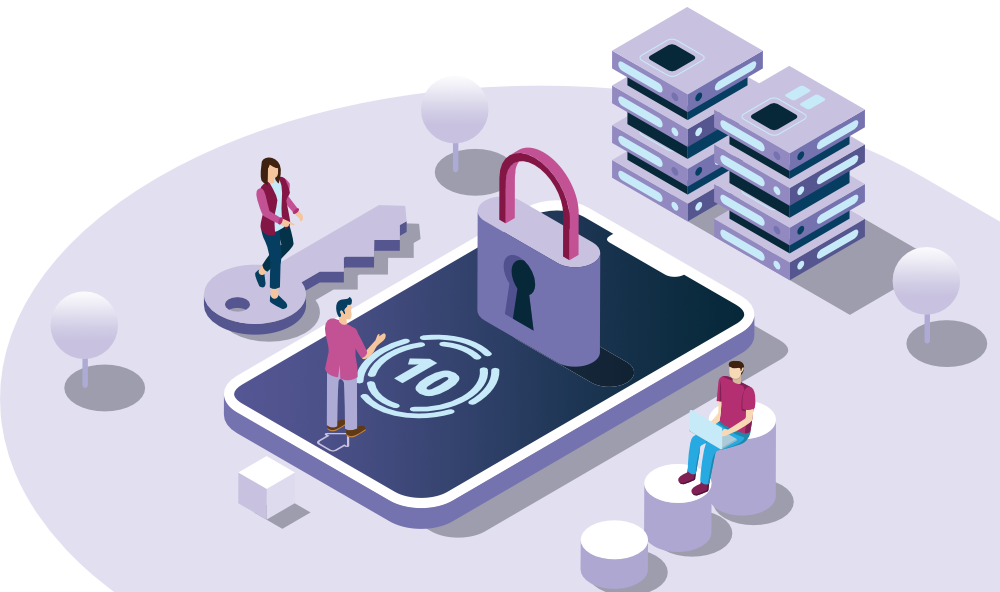
Online privacy and data protection are two separate concepts. Privacy means who can see and access your data, while protection refers to the policies and regulations that restrict access. For this, companies regulate compliance standards to protect users’ privacy.
Mostly, private and protected data includes personal health and personally identifiable information. It is critical in every niche and sector and help companies prevent data breaches and damage to the company name. It involves technologies and works that safeguard data, including built-in storage, firewalls, encryption, and complete protection.
Difference Between Data Protection and Data Privacy
Although data protection and data privacy often come together in the same context, there is some difference between them.
The first difference is based on their work. Data privacy defines who can access your data. On the other hand, data protection manages those restrictions. Together, data privacy describes policies, and data protection tools that employ them.
It means you can create policies and guidelines, but that doesn’t restrict access to it. In the same way, you can limit access with protection tools, but some data may be left vulnerable without proper guidelines. So, you need both of them to secure data, and we will go over them one by one.
Practices to Protect Your Online Data
There are several ways to store and manage your data to ensure security. The following practices will help you do so by restricting access, monitoring activity, and taking action on threats.
Data Evaluation
Before you can protect the data, you must discover your data. The important things to know are which data exists, which is confidential information, and what might be better behind compliance standards.
Data Loss Prevention
You can prevent data loss and restrict access to it by using prevention tools. Many such tools help you in case the data is stolen, damaged, or lost and also assist in recovering it.
Protective Storage
Modern-day technologies and tools feature built-in protection, which serves its purpose well. It keeps all the critical information safe, prevents tracking or apps from storing it, and protects your data to the fullest.
Backups
Backups are very important, especially if you have lots of data. You should create copies of it and store them in a location other than their original place. It will help restore the data in case it gets damaged or lost. In addition, backups are critical in a business or a company as they help make data available in case of an emergency.
Snapshots
Snapshots are like backups but in an image format. It captures the data and the files present in the protected system. A snapshot can help restore the entire system to a specific point in case you need it.
Duplication
Duplication or replication is the way to copy data from one protected location and save it in another. You can do this on a routine basis or whenever you want. It will help keep up-to-date copies of the data and allow recovery in time.
Firewalls
Firewalls help filter out internet traffic and prevent unauthorized access to your system. Moreover, it monitors the ongoing and incoming traffic and only allowed users can access it or make changes to settings. You can adjust it according to your usage and needs but always keep it enabled to have extra protection against cyberattacks.
Authentications and Authority
These values control and ensure the credentials are saved by the user. Also, they verify the authenticity of privileges used by the user. It is part of the identity and access management system.
Encryption
It is a protective barrier that changes the contents of the data through an algorithm. After that, only the right key can open the lock to access the data. So, even if your data is stolen or hacked, it is unreadable, and no one other than the authorized person can access it.
End Protection
A software that helps protect the gateways to your system. This includes the ports, routers, and devices connected to the server. With the help of endpoint protection, you can monitor the oncoming traffic and filter it to keep the network and server safe.
Data Erasure
It analyzes and processes the data periodically and erases the segments that are no longer needed or are irrelevant. This limits liability and loss chances while keeping the most important data within reach. Erasing unnecessary data is also mandatory as per the GDPR.
Data Recovery
Data recovery refers to the steps taken by a company in response to a disaster like a cyberattack, device failure, or natural disaster. It involves a set of practices and technologies that handle post-attack scenarios. It sets up a remote recovery site that contains copies of data, and you can switch to it in times of need.
Practices to Maintain Your Online Privacy
Maintaining standard privacy is important to ensure that protection tools do their job correctly. Although it may seem hard, it is not impossible, especially when we are here. Here are a few best policies and rules to ensure complete privacy.
Keep Track of Data
An important part of ensuring data privacy and protection is understanding your data. Also, it is necessary to evaluate data handling and storage. After that, make sure your policies define collecting and storing the information and data. For example, you need to set the time when the data is monitored and checked.
Limit Data Collection
Another important thing to add to the policy is only to allow necessary data collection. If you collect and store more than necessary, it may become a liability on its own. So, it is essential to define rules for data collection, as it will also help save bandwidth and storage. A helpful way to do this is to use the “verify not store” policy where ever you can. This analyzes and verifies users’ data but does not store or transfer it to your system.
Take Consent From Users
Recently, there has been a big fuss about cybersecurity and privacy. Cybercrimes are increasing every year, and no amount of security is enough. Due to this, GDPR has made it necessary to take users’ consent before data collection and storage. Also, many companies are following this policy, like Apple and its strict security regulations. So, make sure to include user consent in your processes and privacy interfaces. Another helpful step is to add an option for the user to opt out of data collection.
Final Takeaway
Online privacy and data protection is a much broader topic, and we have barely scratched its surface. However, these are important guidelines to ensure your data is well-protected when you go online. Also, as a business, it will help you correctly handle user data according to standard rules and regulations.
Still, adding more security is always beneficial, and one form is network security. When you go online, your whole system is open, and armored security will ensure you are well-guarded. For this, you need to opt for an ISP that offers reliable security software with their internet plans, like AT&T and their ActiveArmor security. You can learn more about this by going to their security page https://www.att.com/security/ or contacting their helpline for assistance. For Spanish users, please visit servicio al cliente at&t.
These were some necessary tools and techniques to ensure data privacy and protection. However, it is important to adopt them at the earliest to avoid becoming a target or facing data loss. Be safe, and think one step ahead.

